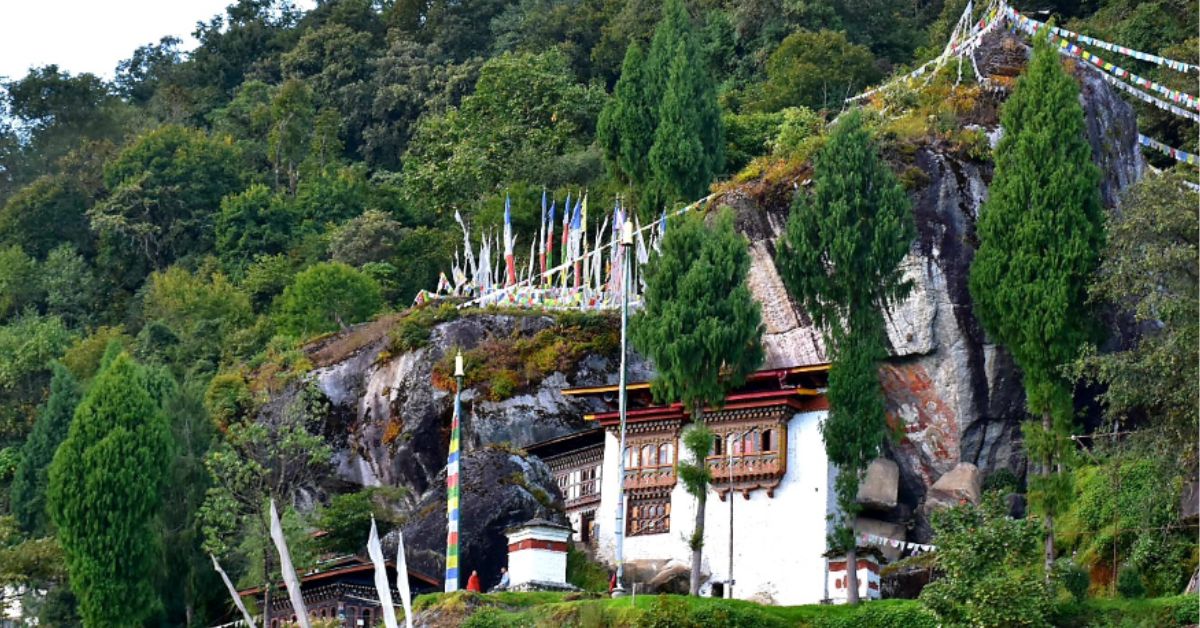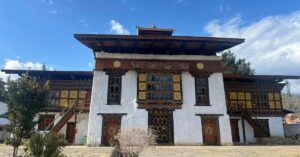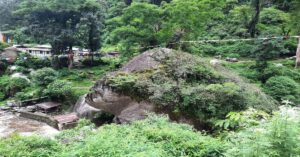Goen Tshephu Ney is a sacred cave of longevity where Guru Rinpoche first met Buddha Amitayus, heard his message, and empowered longevity blessings. The Ney is located in Goenshari Gewog under Punakha Dzongkhag at 2413 meters above sea level.
This sacred cave of longevity is considered the Third Maratika and is believed to be as good as visiting the Draphu Maratika of Nepal. For this reason, Goen Tshephu Ney is popularly known as Bhutan’s Draphu Maratika.
The sacred site of Goen Tshephu derived its name from the cave where the naturally formed stone treasure shaped like the long-life vase (Vase of immortality) appeared after Guru Rimpoche meditated here for 3 months in the 8th century.
How to Reach Goen Tshephu Ney
You’ll drive over 40 km from Khuruthang town to reach the Ney. Drive 25 km from Punakha towards Gasa, until you reach the Goenshari Bridge. From the bridge, divert towards Goenshari, and drive for another 10 km, till you arrive at the Goen Tshephu Ney. Then, walk for 5 minutes from the parking.
Sacred Relics to See at GoenTshephu
- Guru Rinpoche Suung-Joen (self-spoken) Statue;
- The Long Live Vase with the self-arisen letter ཨ (Ah);
- 21 Tara’s Mandala;
- Guru Rinpoche’s Throne;
- Guru Rinpoche’s Kitchen and a cooking oven (Guru’s Soelthab);
- The self-embossed Guru Mantra “OM AH HUNG”;
- The wish-fulfilling tree (Pasam Jinshing);
- Chhimed Tshe Chu (holy water of longevity);
- The gold-plated replica of Zhabdrung’s hat;
- The upper lip of the Mara;
- Three footprints of Guru Rinpoche;
- Dakini meditation cave;
- Wangchu Chenpo with male and female conch.
Also Read: Guru Rinpoche’s Visits to Bhutan and His Sacred Sites
Historical Significance of Goen Tshephu Ney
Goen Tshephu Ney, or the Pungkha Goen Tshephu, is a sacred cave of Guru Rinpoche. It is said that Khandro Yeshey Tshogyal requested Guru Rinpoche to travel to Goen Tshephu when Guru was meditating in the cave of Draphu Maratika. As per the request, they traveled to Goen Tshephu via Tshelung Ney.
Guru Rinpoche meditated in Goen Tshephu for three months in the cave and was able to visualize the full form of Amitayus, “Buddha of Long Life”. As a result, the cave is referred to as the third Maratika.
The Goen Tshephu was also blessed by so many Bodhisattvas, including Terton Dorje Lingpa, Gyalse Gyaltshen, Yongzin Ngawang Drakpa, Thukse Dawa, Trulku Gyaltshen Pelzang, Phajo Drugom Zhigpo, and many more. Terton Pema Lingpa visited and blessed it and left his footprint, which is still visible. Terton Dorji Lingpa visited and discovered a ritual dagger (phurpa), now one of the inner relics of the Goen Tshephu Lhakhang.
As per the Guru Rinpoche’s prophecy, Zhabdrung Ngawang Namgyel traveled to Punakha in search of a location for the Drukpa seat, leading him to Goen Tshephu Ney. He meditated at Goen Tshephu Ney. While meditating, the jealous Shangpa progenies, using their occult power, crashed down meteors. But Zhabdrung’s power diverted them to the cypress tree in front of the room where Zhabdrung was putting in. The split tree can still be seen today.
In Goen Tshephu, Guru Rinpoche appeared in person and advised Zhabdrung to construct Pungthang Dewa Chenpoi Phodrang to propagate the Buddha dharma. Guardian deities of Palden Drukpa also appeared and submitted to support this noble mission.
Description of GoenTshephu Ney
A boulder near the Monastery’s entrance is said to be the upper lip of the Mara conquered by Guru Padmasambhava. Guru Rinpoche has imprinted three footprints on this stone face while flying to Tshechudra. It is said that he stepped on it and flew to Tshechudra in Gasa. Terton Dorje Lingpa’s footsteps are also seen on the same stone. The wish-fulfilling tree (Pasam Jinshing) is also seen nearby, which bears fruits throughout the year.
The main relic of Gon Tshephu Ney is the Life Vase with the self-arisen letter Ah in a small cave. The life vase is believed to have flown from the cave of Maratika in Nepal. It is now housed in a glasshouse to preserve its sanctity. A Chhimed Tshe Chu (holy water of longevity/no death) trickles from the rock top, believed to be an elephant’s tongue. This longevity water is channeled in a tap at the entrance from the main Tshe Bum (the Vase of Immortality) cave.
Aside from the Dakini meditation cave, there is a cave (Dedh Drib Ney) where good and bad Karma can be determined. Returning to the monastery and rising higher, a self-arisen 21 Tara’s picture may be observed in a cave face, thought to be hidden there.
A cooking oven (Guru’s Soelthab) is on top of the large rock above the monastery, which Khandro used for preparing food for Guru Rinpoche. A stunning self-arisen letter OM AH HUNG can be seen below the Monastery on the backside of Mara’s top lip. All of the letters are raised letters if you look closely. Wangchu Chenpo with male and female conch can be observed. On the stone’s face is a small hole where Terton Dorje Lingpa extracted Phurbi Ter.
Goen Tshephu Lhakhang
Tsephu Trulku Gyeltshen Pelzang, a follower of Saint Goe Tsangpa, founded the Goen Tshephu monastery. Since the temple was old and small, the Royal great-grandmother, Late Queen Azhi Phuentsho Choden Wangchuck, renovated and enlarged it in 1958 to accommodate increasing devotees while conducting rituals and prayers on auspicious days (Yarngo- 15th day and marngo- 30th day).
The main statue in the Monastery is Guru Suung-Joen Thoed Threng Rig Nga. The Thoe Threng Rig Nga refers to the Guru’s Body, Speech, Mind, Quality, and Activity. Pentsa Deva, the Nepali sculptor, crafted this statue in Punakha Dzong to be taken to Bumthang Kurjey Lhakhang. However, the statue spoke, “Place me at Goen Tshephu instead of taking me to Bumthang”. Thus, the statue is considered the most revered relic at Goen Tshephu.
The other two statues of Guru Rimpoche sculptured by Pentsa Dewa in Punakha Dzong, who spoke, are that of Paro Taktshang Monastery and Ragoe Ney Goenpa in Paro.
Among the temple’s countless relics, the gold-plated replica of Zhabdrung’s hat is also considered one of the main treasures.
Best Time to Visit Goen Tshephu
Any time of the year is suitable for a pilgrimage to Goen Tshephu Ney. Going on a pilgrimage during the summer months is possible, but it is not usually recommended because the weather in the hilly countryside is unpredictable and changes rapidly. Winters are bitterly cold, and some routes are closed due to severe snowfall, making travel extremely hazardous. As a result, early spring (March, April, May) and autumn (late September, October, and November) are the safest times to visit Goen Tshephu Ney. You can visit major pilgrimage sites of Punakha with the Bhutan Pilgrimage Package.
Places to Explore in Punakha
Punakha Dzong: Also known as Pungthang Dewa Chhenbi Punakha Phodrang, which translates to “the palace of great happiness or bliss,” it is the administrative center of the Punakha District, constructed in 1637 by Ngawang Namgyal.
Chimi Lhakhang: Also known as the fertility temple, it is a Buddhist monastery in Punakha. It was constructed on the site where Drukpa Kunley subdued a demoness. The monastery was founded in 1499 by Lam Ngawang Chogyal.
Talo Monastery: Also known as Talo Sangngak Choling, it is a monastery associated with the mind manifestation of Zhabdrung Ngawang Namgyal, located on the hills above Punakha, Bhutan, at an elevation of approximately 2800 meters.
Chubu Tshachu: Also known as Chubo Tsachu, it is a well-known hot spring in Punakha. The hot spring is said to have been discovered by Guru Rinpoche in the 8th century. Chubu Tshachu is helpful with cold disorders, chronic stomach aches, diabetes, and indigestion.
Kabji-Hoka Tsho: It is a sacred lake in Punakha with an opening in the lake created by the lake’s deity after a demon threatened to flood the area. The hike to Kabji-Hoka Tsho is considered to be of medium difficulty. It takes two to three hours on foot from Chorten Nyingpo Lhakhang.
Punakha Suspension Bridge: This bridge is one of the country’s longest suspension bridges, spanning approximately 180 meters over the Pho Chhu River. The bridge connects Punakha Dzong with Punakha town and nearby villages.
Khamsum Yulley Namgyal Chorten: It is a Buddhist monument in Punakha on a hilltop overlooking the Mo Chhu River, constructed in 1992 to ward off evil spirits and to bring peace and harmony to all living beings.
Enjoyed reading this blog?




